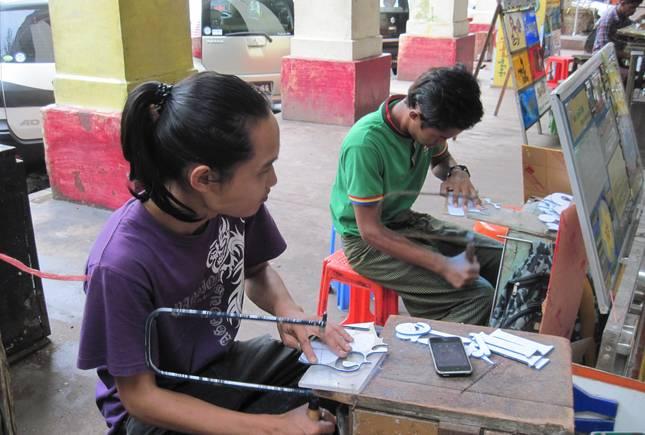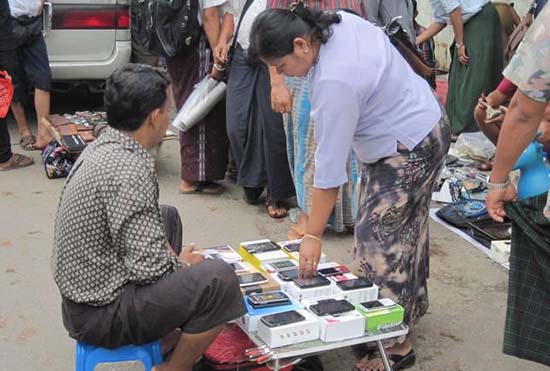AT a street corner in Kamayut Township, Yangon, a young man does what would be seen as freakish in his country just three or four years ago – he lowers his head, fixes his eyes on his smart phone, swipes the screen and smiles at it.
The SEAPA Fellowship program was concluded on 31st August, 2013. And, the final stories are already published in their news organization starting from last week.
As SEAPA fellowship aims to distribute the stories as far and wide as possible across the region especially on Burma and Singapore. Their stories will be carried by different media outlets in Burma and other countries, too. (as SEAPA owns the copyright of the stories.) As of Burma, Irrawaddy and Myanmar Freedom Daily News has carried a few of our stories.
AT a street corner in Kamayut Township, Yangon, a young man does what would be seen as freakish in his country just three or four years ago – he lowers his head, fixes his eyes on his smart phone, swipes the screen and smiles at it.
 He is probably in his 20s, dressed casually in a black striped shirt and dark jeans, which makes him stand out in the crowd of people wearing the traditional longyis (cloth worn as a long skirt). Still, he is not uncommon among the Burmese of his generation, especially those on the streets of downtown Yangon these days.
He is probably in his 20s, dressed casually in a black striped shirt and dark jeans, which makes him stand out in the crowd of people wearing the traditional longyis (cloth worn as a long skirt). Still, he is not uncommon among the Burmese of his generation, especially those on the streets of downtown Yangon these days.
More and more young Burmese are joining their smartphone-toting peers elsewhere in the world: a generation that cannot imagine their lives without their all-in-one gadget.
Amidst the traditional or even nostalgic atmosphere, a traveller would get the feeling that Myanmar is finally catching up with the outside world after strict military rule of over five decades.
The opening up of the telecommunications services has presented opportunities for the people to connect to the global village. There is a strong hope that access to information and having-the-right-to-choose values can help the democratisation process, especially during this important transition period.
However, this new and exciting online platform has also been used by some groups who, many fear, are trying to set malicious agendas by posting insensitive hate speeches or remarks.
The inherent divisions in the country between majority Buddhists and minority Muslims and Rohingyas (also known as Bengali by most Burmese), as well as the majority Burman and other minority ethnic groups, have driven online users to take sides, resulting in inflamatory views on the sectarian clashes that flared up in March last year.
Political observers, drawing lessons from history, suspect that religious clashes were following the pattern in the past: They happened when those in power felt threatened or challenged. This was common during the British colonial era up till the military rule after Independence.
The prevalent view is that the old dogs of the regime may want to further divide the deeply fragmented country, while the pro-democracy movement is trying to hold it together.
Facebook, the most popular social media site in Myanmar, is believed to have become a new political battleground for the ruling Union Solidarity and Development Party (USDP) and the biggest opposition party National League for Democracy (NLD), which are gearing up to the 2015 presidential election.
It may come as a surprise to an outsider who finds it easier to contact a Burmese friend through Facebook than email, as many are able to access the site using smartphones.
It is estimated that around 1% of Myanmar's population of nearly 60 million are Facebook users, according to Nay Phone Latt, the executive director of Myanmar ICT for Development Organisation (MIDO).
For Ye Naing Moe, director of Yangon Journalism School, although the internet penetration is just 1% of the population, those who have access to the internet are influential people. Online activities are increasing among the ruling elites, media practitioners, military officers, educated monks – people who can change the political and social landscape in the country.
"Online people are influential people. They are able to shape the society. In small towns where only a few people can go online, those who can, serve as the eyes and ears of their communities," Ye said.
Among the big-name Facebook users is President U Thein Sein who actively communicates with the populace through his Facebook page, which features photos of his official events and statements. He has 11,800 followers.
Another popular USDP leader, Deputy Minister of Information Ye Htut, has 47,000 Facebook followers. Opposition icon Aung San Suu Kyi's party National League for Democracy (NLD) official page has 221,000 followers.
According to the statistics from various sources released last year, 29.7% of global Facebook users are mainly young people in the 25-34 age bracket, while 50% of users who are 18-24 go to Facebook when they wake up in the morning. Myanmar's statistics are unavailable, but internet usage is defnitely coming on strong in the country.
Thinzar Shunlei Yi, 21, is among those riding this wave following the the opening up of the telecommunication services. She surfs the internet using her smartphone, and checks her Facebook or email account in the morning.
However, the online life remains a distant reality for the majority of the society.
Many in Yangon earn a meager US$1 a day, while a desktop computer with an LCD screen and operating system ready is about 400,000 kyats (about US$ 400) and a Lenovo Thinkpad US$ 1,300.
Even for Shunlei, a fresh graduate of Institute of Education who comes from a military family, can only own her very first phone with Android 2.1 Eclair version. It cost a relatively moderate US$ 100 and was given to her by her uncle as a gift this year.
"Unfortunately, it is version 2.1. I can't use it as well as those belonging to other youths," Shunlei said. She had to fork out about US$ 10 for an initial sign-up of 2G service.
Currently, Android phone users are using the 4.3 Jelly Bean version.
A stroll down on a street adjacent to the Bogyoke Aung San Road, one couldn't help but notice the vibrant mood in the air. People squatted in front of a line of mats displaying goods, looking for scrap computer parts or testing out the latest smartphones on sale.

Before 2010, an individual needed to pay almost US$ 3,000 for a subscription identity module or SIM card. Now, they can buy one with 3G access for slightly over US$ 400. Although this is still unbelievably expensive, many are able to own a SIM card now.
As the mobile Internet service becomes more commonly available, many issues related to the internet usage have also arrived at Myanmar's doorsteps.



